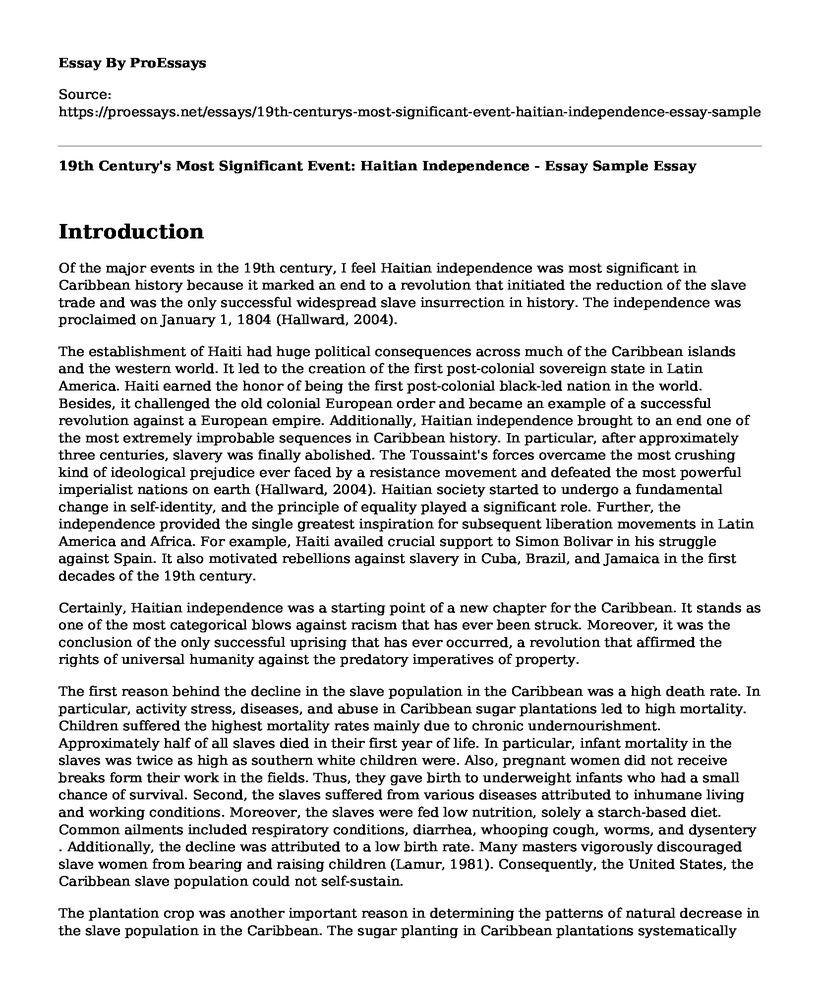Introduction
Of the major events in the 19th century, I feel Haitian independence was most significant in Caribbean history because it marked an end to a revolution that initiated the reduction of the slave trade and was the only successful widespread slave insurrection in history. The independence was proclaimed on January 1, 1804 (Hallward, 2004).
The establishment of Haiti had huge political consequences across much of the Caribbean islands and the western world. It led to the creation of the first post-colonial sovereign state in Latin America. Haiti earned the honor of being the first post-colonial black-led nation in the world. Besides, it challenged the old colonial European order and became an example of a successful revolution against a European empire. Additionally, Haitian independence brought to an end one of the most extremely improbable sequences in Caribbean history. In particular, after approximately three centuries, slavery was finally abolished. The Toussaint's forces overcame the most crushing kind of ideological prejudice ever faced by a resistance movement and defeated the most powerful imperialist nations on earth (Hallward, 2004). Haitian society started to undergo a fundamental change in self-identity, and the principle of equality played a significant role. Further, the independence provided the single greatest inspiration for subsequent liberation movements in Latin America and Africa. For example, Haiti availed crucial support to Simon Bolivar in his struggle against Spain. It also motivated rebellions against slavery in Cuba, Brazil, and Jamaica in the first decades of the 19th century.
Certainly, Haitian independence was a starting point of a new chapter for the Caribbean. It stands as one of the most categorical blows against racism that has ever been struck. Moreover, it was the conclusion of the only successful uprising that has ever occurred, a revolution that affirmed the rights of universal humanity against the predatory imperatives of property.
The first reason behind the decline in the slave population in the Caribbean was a high death rate. In particular, activity stress, diseases, and abuse in Caribbean sugar plantations led to high mortality. Children suffered the highest mortality rates mainly due to chronic undernourishment. Approximately half of all slaves died in their first year of life. In particular, infant mortality in the slaves was twice as high as southern white children were. Also, pregnant women did not receive breaks form their work in the fields. Thus, they gave birth to underweight infants who had a small chance of survival. Second, the slaves suffered from various diseases attributed to inhumane living and working conditions. Moreover, the slaves were fed low nutrition, solely a starch-based diet. Common ailments included respiratory conditions, diarrhea, whooping cough, worms, and dysentery . Additionally, the decline was attributed to a low birth rate. Many masters vigorously discouraged slave women from bearing and raising children (Lamur, 1981). Consequently, the United States, the Caribbean slave population could not self-sustain.
The plantation crop was another important reason in determining the patterns of natural decrease in the slave population in the Caribbean. The sugar planting in Caribbean plantations systematically combined a lethal combination of aspects such as the labor regime that continuously produced natural decline among slaves (Lamur, 1981). In particular, the labor in sugar plantation took a heavy toll on the slave's health and fertility, which lowered their numbers significantly. Additionally, the sugar planters skewed their labor force towards men since based on their calculations; their doing so would maximize profits. Finally, the fertility level of the slaves in the Caribbean also contributed to the declining numbers. In particular, slave women in the Caribbean had low fertility levels. Certainly, the fertility reducing effect of the nature of the work was reinforced by the effect of the size of sugar plantations in the region. Consequently, the slave populations of the British Caribbean were maintained only by ongoing replenishment through immigration. Most of the slaves were imported from Africa.
References
Hallward, P. (2004). Haitian Inspiration: On the bicentenary of HaitiaEUR s independence. Radical Philosophy, 123, 1-7. https://libcom.org/files/Haitian%20inspiration.pdf
Lamur, H. E. (1981). Demographic performance of two slave populations of the Dutch speaking Caribbean. Boletin de estudios latinoamericanos y del Caribe, (30), 87-102. https://pure.uva.nl/ws/files/2782414/178630_534834.pdf
Cite this page
19th Century's Most Significant Event: Haitian Independence - Essay Sample. (2023, Jun 08). Retrieved from https://proessays.net/essays/19th-centurys-most-significant-event-haitian-independence-essay-sample
If you are the original author of this essay and no longer wish to have it published on the ProEssays website, please click below to request its removal:
- Hagia Sophia: Istanbul's Mystery
- Pearl Harbor - Movie Review
- Critical Essay on Frederick Douglass Speech: Black America Vision
- Saint Elizabeth (1271-1336) Essay Example
- Jacob Lawrence Biography Paper Example
- Essay Sample on Nixon's Vietnam War Policy: An Unsuccessful End to a Costly Conflict
- The Ideas of Lev Vygotsky Definitions Essay







